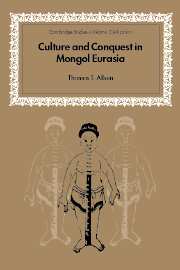Book contents
- Frontmatter
- Contents
- Preface
- Note on transliteration
- Abbreviations
- PART I BACKGROUND
- PART II POLITICAL–ECONOMIC RELATIONS
- 3 Formation of the Il-qans, 1251–1265
- 4 Grand Qans and Il-qans, 1265–1295
- 5 Continuity and change under Ghazan, 1295–1304
- 6 Sulṭāns and Grand Qans, 1304–1335
- 7 Economic ties
- 8 Overview of the relationship
- PART III INTERMEDIARIES
- PART IV CULTURAL EXCHANGE
- PART V ANALYSIS AND CONCLUSIONS
- Bibliography
- Index
- Other titles in the series
4 - Grand Qans and Il-qans, 1265–1295
Published online by Cambridge University Press: 04 September 2009
- Frontmatter
- Contents
- Preface
- Note on transliteration
- Abbreviations
- PART I BACKGROUND
- PART II POLITICAL–ECONOMIC RELATIONS
- 3 Formation of the Il-qans, 1251–1265
- 4 Grand Qans and Il-qans, 1265–1295
- 5 Continuity and change under Ghazan, 1295–1304
- 6 Sulṭāns and Grand Qans, 1304–1335
- 7 Economic ties
- 8 Overview of the relationship
- PART III INTERMEDIARIES
- PART IV CULTURAL EXCHANGE
- PART V ANALYSIS AND CONCLUSIONS
- Bibliography
- Index
- Other titles in the series
Summary
Hülegü's campaigns against the Ismāʾīlīs and ʿAbbāsids were the last joint military ventures of the unified Mongolian Empire. Thereafter, the Chinggisid princes increasingly turned their military energies inward in a confrontation that lasted, with fits and starts, into the fourteenth century. The accumulating tensions between rival lines which had temporarily surfaced at the accessions of Güyüg and Möngke became permanent divisions during the Toluid civil war. By the time Qubilai successfully claimed the qaghanate in 1264, the empire had fragmented into four regional and independent qanates.
To summarize, the new alignment saw the formation of one Jochid, one Chaghadaid, and two Toluid polities. In the East, Qubilai, who vanquished Ariq Böke by relying on the resources of China, moved the Mongolian capital from Qara Qorum to Peking. While his administrative authority was restricted to his own domains, he continued to assert his sovereignty as Grand Qan over the whole of the empire. His territories, formally called the Yuan in 1271, ultimately embraced China, Manchuria, Mongolia, East Turkestan, Tibet, Korea, and parts of Southeast Asia. In central Asia, most of the Chaghadaids first supported Qubilai but in 1269 joined forces with the deposed Ögödeid line, under the leadership of Qaidu (d. 1301), in an attempt to drive the qaghan from his throne. The major battlegrounds between these rivals were the Uighur lands and western Mongolia.
- Type
- Chapter
- Information
- Culture and Conquest in Mongol Eurasia , pp. 24 - 30Publisher: Cambridge University PressPrint publication year: 2001
- 2
- Cited by



